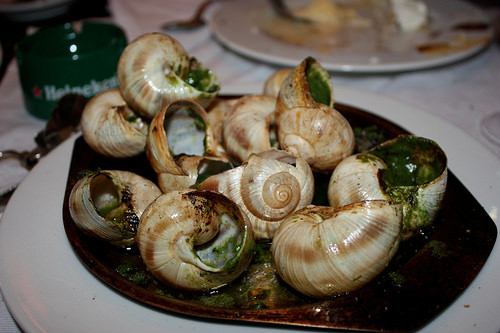Slugs and snails are generally distinguished by the presence of a large exterior shell on the back of snails. Snails and slugs are both gastropod mollusks, and unlike most gastropods they are terrestrial i.e. found on land.
Comparison chart
Anatomy
The only significant morphological difference between the slug and the snail is the snail’s conspicuous shell. This shell is large enough for the snail to completely retract into for defense. Some snails are also able to close off their shell once fully retracted.
Slugs do not have this convenience of a mobile home for defense. Instead, many slugs have an internal vestigial shell to store calcium. Because there's no shell for protection, their soft tissues are prone to desiccation.
Other than this big exterior feature, both mollusks have several similar features, like eye spots at the end of slender tentacles, downward-directed mouths, and single, broad, muscular, flat-bottom feet, which is lubricated by mucus and covered with epithelial cilia.
Physiology
Learn some quick facts about the banana slug, a specific variety of slug through this Redwood Ranger video:
Below is a detailed video of the land snail, or as we commonly call it, the snail - its anatomy, habitat and food habits :
Speed - Which is Faster, Snail or Slug?
There are thousands of species of slugs and snails, and they all crawl at different speeds. The speed of a common snail is about 1 millimeter per second, or 0.002 mph. Some snail species are faster than some slug species, and some snails do not move at all — they stay put at the bottom of the sea and feed on any plankton that may drift their way.
Movement
The way snails and slugs move can be very interesting. In most snails, waves of muscular contractions sweep along the length of their foot to produce a stepping motion. In effect, they move on only one foot.
Habitat
Because there's no shell, the slug can maneuver and compress itself into hiding places with very little space, e.g. loose bark on trees or beneath stone slabs and wooden boards. This gives it a great environmental and survival advantage.
Snails trade off that flexibility for the ability to quickly retreat into their shells for protection, especially from its natural enemies.
Both slugs and snails prefer hot and humid climates with ample shade for hiding.
Varieties
There are over 60 varieties of snails and more than 20 varieties of slugs found in Montana, USA alone. This video is a precursor to the many types of mollusks we come across:
Slugs and Snails as Food
Both slugs and snails have been used as a food source for humans, providing an easily harvested source of protein. Historically, slugs and snails have proven especially useful as famine food, and in some countries, such as France, Spain, Indonesia, and the Philippines, are relished as a gourmet food.







 Hornet
Hornet  Turtle
Turtle  Squid
Squid  Amphibian
Amphibian  Mouse
Mouse  Alligator
Alligator
Comments: Slug vs Snail